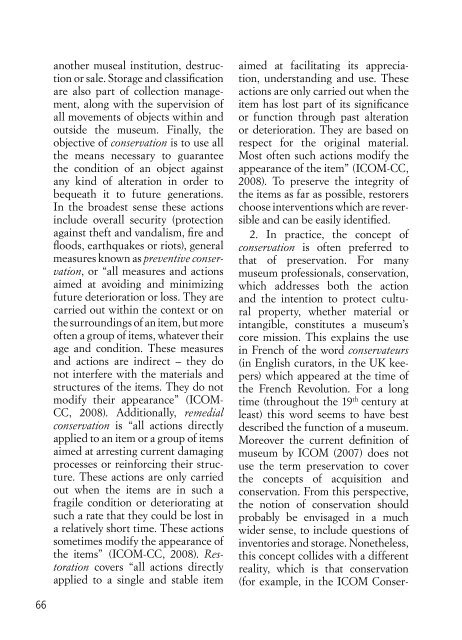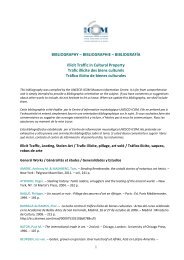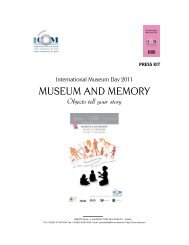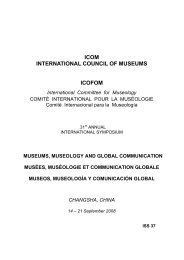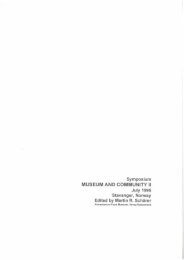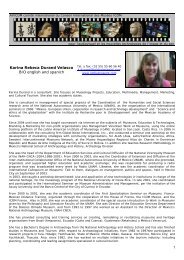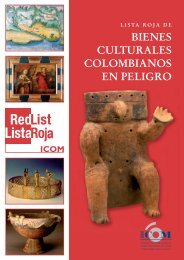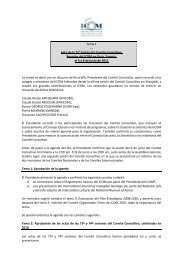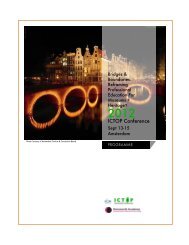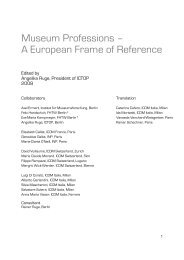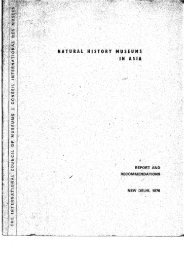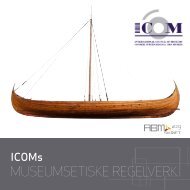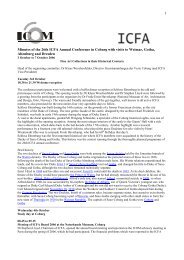Key Concepts of Museology - ICOM
Key Concepts of Museology - ICOM
Key Concepts of Museology - ICOM
Create successful ePaper yourself
Turn your PDF publications into a flip-book with our unique Google optimized e-Paper software.
66<br />
another museal institution, destruction<br />
or sale. Storage and classifi cation<br />
are also part <strong>of</strong> collection management,<br />
along with the supervision <strong>of</strong><br />
all movements <strong>of</strong> objects within and<br />
outside the museum. Finally, the<br />
objective <strong>of</strong> conservation is to use all<br />
the means necessary to guarantee<br />
the condition <strong>of</strong> an object against<br />
any kind <strong>of</strong> alteration in order to<br />
bequeath it to future generations.<br />
In the broadest sense these actions<br />
include overall security (protection<br />
against theft and vandalism, fi re and<br />
fl oods, earthquakes or riots), general<br />
measures known as preventive conservation,<br />
or “all measures and actions<br />
aimed at avoiding and minimizing<br />
future deterioration or loss. They are<br />
carried out within the context or on<br />
the surroundings <strong>of</strong> an item, but more<br />
<strong>of</strong>ten a group <strong>of</strong> items, whatever their<br />
age and condition. These measures<br />
and actions are indirect – they do<br />
not interfere with the materials and<br />
structures <strong>of</strong> the items. They do not<br />
modify their appearance” ( <strong>ICOM</strong>-<br />
CC, 2008). Additionally, remedial<br />
conservation is “all actions directly<br />
applied to an item or a group <strong>of</strong> items<br />
aimed at arresting current damaging<br />
processes or reinforcing their structure.<br />
These actions are only carried<br />
out when the items are in such a<br />
fragile condition or deteriorating at<br />
such a rate that they could be lost in<br />
a relatively short time. These actions<br />
sometimes modify the appearance <strong>of</strong><br />
the items” ( <strong>ICOM</strong>-CC, 2008). Restoration<br />
covers “all actions directly<br />
applied to a single and stable item<br />
aimed at facilitating its appreciation,<br />
understanding and use. These<br />
actions are only carried out when the<br />
item has lost part <strong>of</strong> its signifi cance<br />
or function through past alteration<br />
or deterioration. They are based on<br />
respect for the original material.<br />
Most <strong>of</strong>ten such actions modify the<br />
appearance <strong>of</strong> the item” ( <strong>ICOM</strong>-CC,<br />
2008). To preserve the integrity <strong>of</strong><br />
the items as far as possible, restorers<br />
choose interventions which are reversible<br />
and can be easily identifi ed.<br />
2. In practice, the concept <strong>of</strong><br />
conservation is <strong>of</strong>ten preferred to<br />
that <strong>of</strong> preservation. For many<br />
museum pr<strong>of</strong>essionals, conservation,<br />
which addresses both the action<br />
and the intention to protect cultural<br />
property, whether material or<br />
intangible, constitutes a museum’s<br />
core mission. This explains the use<br />
in French <strong>of</strong> the word conservateurs<br />
(in English curators, in the UK keepers)<br />
which appeared at the time <strong>of</strong><br />
the French Revolution. For a long<br />
time (throughout the 19 th century at<br />
least) this word seems to have best<br />
described the function <strong>of</strong> a museum.<br />
Moreover the current defi nition <strong>of</strong><br />
museum by <strong>ICOM</strong> (2007) does not<br />
use the term preservation to cover<br />
the concepts <strong>of</strong> acquisition and<br />
conservation. From this perspective,<br />
the notion <strong>of</strong> conservation should<br />
probably be envisaged in a much<br />
wider sense, to include questions <strong>of</strong><br />
inventories and storage. Nonetheless,<br />
this concept collides with a different<br />
reality, which is that conservation<br />
(for example, in the <strong>ICOM</strong> Conser-


